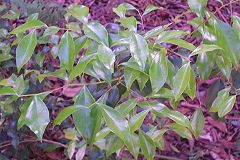Scolopia
| Scolopia subsp. var. | ||||||||||||||||||||||||||||||||||||||||||||||||||||||||
|---|---|---|---|---|---|---|---|---|---|---|---|---|---|---|---|---|---|---|---|---|---|---|---|---|---|---|---|---|---|---|---|---|---|---|---|---|---|---|---|---|---|---|---|---|---|---|---|---|---|---|---|---|---|---|---|---|

|
|
| ||||||||||||||||||||||||||||||||||||||||||||||||||||||
| ||||||||||||||||||||||||||||||||||||||||||||||||||||||||
Scolopia is a genus of plants in family Salicaceae.
| Standard Cyclopedia of Horticulture |
|---|
|
Scolopia (Greek, thorn or stake, probably so named on account of the spines). Flacourtiaceae. Spiny trees, the spines often compound, one of which, S. crenata, has been intro. in S. Calif.: lvs. alternate, entire; stipules minute or none: fls. small, racemed, axillary, dioecious; sepals 4-6; petals 4-6, subsimilar; stamens many; ovary 1-celled: berry 2-4-seeded.—About 30 species, Afr., Asia, and Austral.
|
Cultivation
Propagation
Pests and diseases
Species
Notable species are:
- Scolopia oreophila (Sleumer) Killick
- Scolopia braunii (Klotzsch) & Sleumer - an Australian rainforest tree
- Scolopia mundii
- Scolopia rhinanthera
- Scolopia steenisiana Sleumer
Gallery
-
photo 1
-
photo 2
-
photo 3
References
- Standard Cyclopedia of Horticulture, by L. H. Bailey, MacMillan Co., 1963
External links
- w:Scolopia. Some of the material on this page may be from Wikipedia, under the Creative Commons license.
- Scolopia QR Code (Size 50, 100, 200, 500)
